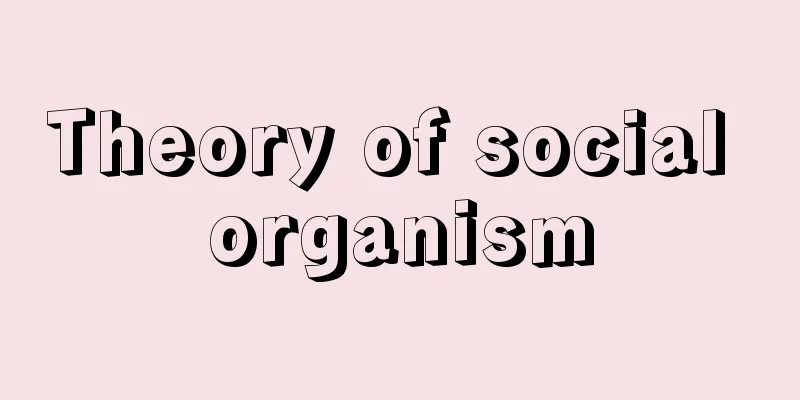Theory of social organism

|
This is a view of society that compares society to a biological organism, and is contrasted with the social organism theory. The social organism theory, which sees society as having a mechanical mechanism, considers society as a whole to be made up of an accumulation of parts, just as a clock can be disassembled, cleaned, and reassembled. In contrast, the social organism theory, which compares society to a biological organism, believes that if an organism is disassembled into parts, it will die, and no matter how many dead parts are piled up, life will not return to it. In other words, the whole is not made up of parts, but the whole precedes the parts. If we take the analogy with the organism further and compare social division of labor to the functional differentiation of the organs of an organism and their interdependence, we arrive at the functionalist view that each part of society exists with functions to maintain the whole. This type of social organism theory can be found in the classical synthetic sociology of Comte and Spencer. Spencer in particular tried to show that the general laws of evolution, namely the increase in volume, the development of integration, and the transition from homogeneity to heterogeneity, apply to social organisms as well as to individual organisms. The Russian sociologist Lilienfeld identified all the functions of society with those of an organism. The German sociologist Schäffele used many of these analogies in the first edition of The Structure and Life of the Social Body (1875), but he used them less in later editions and later abandoned the organism theory. The Belgian sociologist Guillaume Joseph De Greef (1842-1924) considered society to be the "highest degree of organism" that is subject to the same laws of progress and regression as biological organisms. In France, Espinas and Worms were the representatives, and the former tried to prove that living organisms, as a collection of cells and other organic factors, are already societies. Just as Worms first adopted the social organism theory but later abandoned it, most social organismists have abandoned their original narrow-minded view, and today such thinking has been overcome. [Eizaburo Koga] "Spencer's Sociology" by J. Lamnay, translated by Takao Yamada (1970, Fumaisha) " ▽ "World Masterpieces 36: Comte/Spencer" edited by Kazuo Okochi et al. (1970, Chuokoron-Shinsha) [Reference items] | |Source: Shogakukan Encyclopedia Nipponica About Encyclopedia Nipponica Information | Legend |
|
社会を生物有機体になぞらえて把握する社会観で、社会機構体説と対比される。社会を機械的なメカニズムをもつものととらえる社会機構体説では、ちょうど時計を分解して掃除し再度組み立てることができるように、社会も全体が部分の積み重ねでできていると考えられる。これに反して、社会を生物有機体になぞらえる社会有機体説では、生物を部分に分解すれば死んでしまうから、一度死んだ部分をいくら積み重ねても生命は戻らない、つまり全体は部分からなるのでなく、全体は部分に先だつという考え方になる。さらに有機体とのアナロジーを推し進めて、社会的分業を有機体の諸器官の機能分化とその相互依存になぞらえれば、社会の諸部分は全体を維持するための諸機能をもって存在するという機能主義的な考え方に帰着する。 このような社会有機体説は、コント、スペンサーの古典的な総合社会学にみられる。とくにスペンサーは、進化の一般法則、つまり容積の増大、統合の発達、同質性から異質性への移行という法則が、個人有機体と同様、社会有機体にも適用されることを示そうとした。ロシアの社会学者リリエンフェルトは社会のあらゆる諸機能を有機体の諸機能と同一視した。ドイツの社会学者シェッフレは『社会体の構造と生命』(1875)の初版ではこうしたアナロジーを多く用いていたが、後の版ではその割合は減り、のちには有機体説を断念した。ベルギーの社会学者ド・グレーフGuillaume Joseph De Greef(1842―1924)は、社会を、生物有機体と同じ進歩と退歩の法則に服す「最高度の有機体」とみなした。 フランスでの代表者はエスピナスとウォルムスで、前者は、細胞とその他の有機的な諸要因の集合としての生物がすでに社会であることを論証しようとした。ウォルムスは最初、社会有機体説をとったが、のちにはそれを放棄したように、大部分の社会有機体論者は当初の狭隘(きょうあい)な視点を放棄し、今日ではこのような考え方は克服されている。 [古賀英三郎] 『J・ラムネー著、山田隆夫訳『スペンサーの社会学』(1970・風媒社)』▽『大河内一男他編『世界の名著36 コント/スペンサー』(1970・中央公論社)』 [参照項目] | |出典 小学館 日本大百科全書(ニッポニカ)日本大百科全書(ニッポニカ)について 情報 | 凡例 |
>>: Social Problems Research Society
Recommend
Matsudaira Sadakatsu
Year of death: 14 March 1624 (1624.5.1) Year of bi...
Eiji Amou
1887-1968 A diplomat from the Taisho to Showa era...
Muhammad b. al-Hanafiya (English spelling)
…However, Shiites strongly believe that this usag...
Positronium - Positronium (English spelling)
A bound state in which an electron and its antipa...
Quotation marks - info
A symbol used to indicate a quotation when posting...
Arafat (place name) - Arafat
...Pilgrims, clad in two seamless white cloths (i...
Lithops gracilidielineata (English spelling)
… [Hiroshi Yuasa]. … *Some of the terminology tha...
grammaire comparee (English notation) grammaire comparee
...It was Goethe who told Dietz about the existen...
One-sided license - One-sided license
…The first type is a patent or know-how license a...
Heinrich Wittenweiler
A Swiss poet of the late Middle Ages. Also known a...
Stribog
… [Origin of the Gods] The Primary Chronicle (als...
Southwark
It is one of the 33 districts that make up Greater...
Comet
It is also called a comet. In English, the word c...
Alor Setar (English spelling)
The capital of Kedah state in the northwest of the...
Tangaloa - Tangaloa (English spelling)
Along with Tānetūrongo, Tangaroa is a god who hold...









